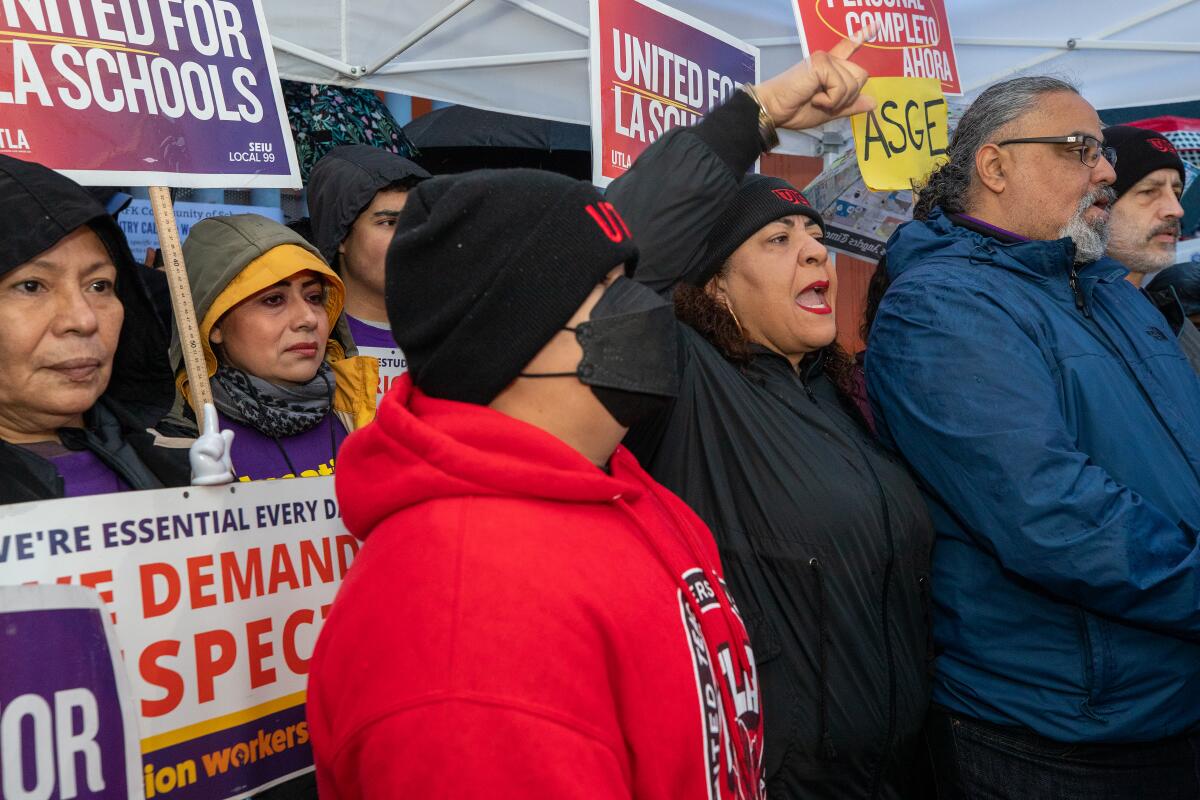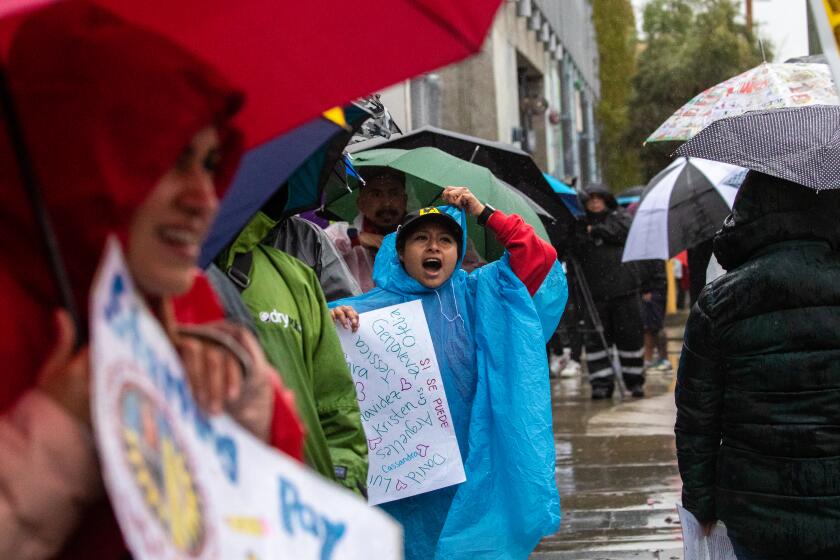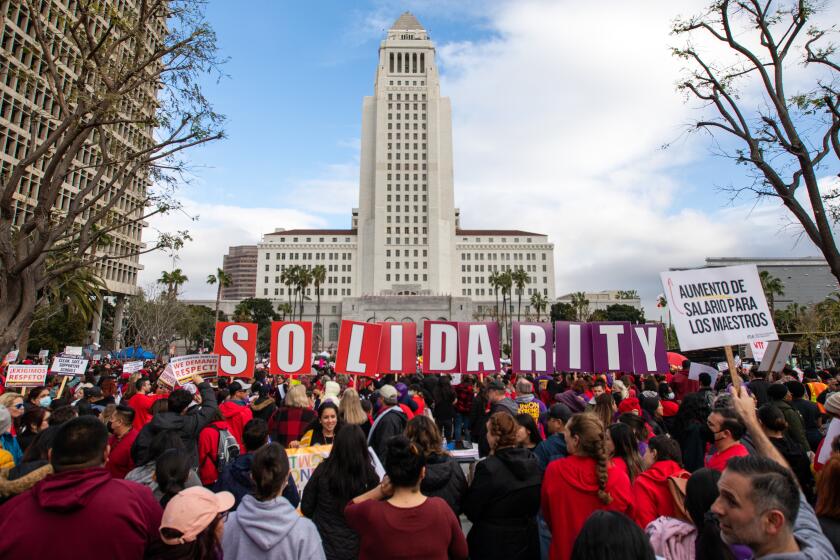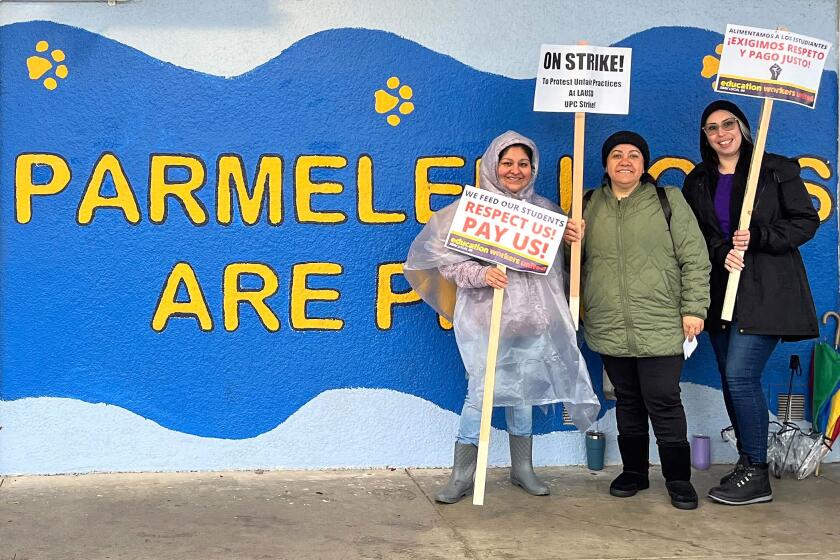Column: Another LAUSD strike: It’s hell on families, but workers had no choice

- Share via
Two hours before sunrise Tuesday, what should have been an empty sidewalk outside the LAUSD Van Nuys bus yard on Roscoe Boulevard was bustling.
Dozens of drivers, who would normally be streaming through the gates toward their empty yellow school buses, instead marched back and forth in the rain under a jumble of umbrellas, in the glare of TV news lights. Holding signs demanding respect, they chanted, “If we don’t get it, shut it down.”
So far they haven’t gotten it — that is, a new contract with hefty raises and better working conditions — so they have indeed shut down the country’s second-largest public school system.
Like a lot of Los Angeles Unified School District parents who went through the six-day teachers’ strike in 2019, then months of at-home Zoom school after the COVID-19 pandemic shut the world down, my first thought was, “Oh God, please not again.”
Service Employees International Union Local 99, which represents the least-heralded and lowest-paid public school workers — the bus drivers, the cafeteria workers, the custodians, the gardeners, the teacher aides — called a strike for three days this week, at a moment when every minute of classroom time is precious.
But you know what? I don’t blame the union one bit.
The average annual salary for the school workers Local 99 represents is around $25,000, well below the level considered “very low income” by the federal government. In other words, we pay these folks poverty wages.
Three-quarters of the local’s 30,000 LAUSD workers are women. A third are Latino; a fifth are Black. They’ve been working without a contract since the last one expired in 2020. Most are forced to work less than eight hours a day. Ten thousand do not receive health insurance through the district. They want higher wages, more full-time work, increased staffing levels and, not incidentally, more of that aforementioned respect.
LAUSD bus drivers, custodians, teachers, classroom aides and cafeteria workers join wet, cold picket lines at shuttered schools across the district.
“This over-reliance on a low-wage, part-time workforce makes it difficult for the school district to retain and recruit workers, leading to serious staffing shortages,” a union spokeswoman told my colleague Howard Blume last month after members voted overwhelmingly to authorize a strike.
It felt like just one more slap in the face last month when LAUSD Supt. Alberto Carvalho responded to the vote by comparing the union’s action to a circus.
“Circus = a predictable performance with a known outcome, desiring of nothing more than an applause, a coin, and a promise of a next show,” the superintendent tweeted. “Let’s do right, for once, without circus, for kids, for community, for decency.”
Is it so hard to do right for once by the hardworking folks who keep the bathrooms clean, change the light bulbs, make sure our kids get from home to school and back safely, mow the lawns and help the teachers in their classrooms?
Carvalho deleted his antagonistic tweet, but the union is not about to let him forget it. It’s displayed prominently in retweets online.
Los Angeles Unified School District workers walk out in a strike expected to last through Thursday.
The district’s 25,000 teachers, who are in the middle of their own contract negotiations, are staying home in solidarity with their nonteaching but essential colleagues, which is why parents of the more than 400,000 LAUSD students are scrambling once again.
“We appreciate the teachers supporting our members, but part of our problem is the invisibility of our members — as human beings, and what they do,” said SEIU Local 99’s executive director, Max Arias, who had just finished addressing the strikers with a bullhorn. “They are never in the conversation. This process has made them visible, and I think the parents and the public now realize that these are the people caring for the kids and supporting the teachers, so the kids can get education.”
Dorvel Silva, a 60-year-old bus driver who lives in North Hollywood has driven kids for 15 years. Her 40-foot bus is usually filled with middle schoolers. “We have so much responsibility,” she said. “We’re dealing with kids, traffic, parents, teachers. Believe me, it’s very stressful.”
The union is asking for a 30% wage increase over four years, plus an immediate hourly pay bump of $2. (That would, says the union, bring the minimum hourly wage closer to $25, and annual salaries closer to $36,000, which is, after all, the poverty wage for a family of four.)
The district, by contrast, has offered a 5% wage increase retroactive to July 1, 2021, a second wage increase retroactive to July 1, 2022, and a third increase of 5% that would take effect July 1. Employees would also receive a one-time bonus of 4% for the current year, and a one-time bonus of 5% the next year. This would result, says the district, in a cumulative 23% raise.
A worker at Parmelee Elementary School in South Los Angeles helps prepare over 1,500 meals a day. After 16 years, she makes $1.41 above minimum wage.
Last week, at a news conference, Carvalho said that his offer “does not represent the end of the road, we have more resources and have indicated that to the union.”
I mentioned to Arias that I’d been receiving emails from a teacher at Venice High School about the appalling condition of the campus bathrooms there, some of which, he said, are marked as out of order when in fact they are simply dirty and there is no one to clean them. Clogged toilets and flooded floors are routine, making daily life difficult, not to mention smelly.
Arias was not surprised.
“The district is staffed at 50% of what it claims is the minimum standard of cleanliness,” he told me. “Right now, that’s a crisis. You can’t increase your staff when a custodian that’s been working there for 20 years is not even making $20 an hour.”
Among the union’s demands is an increase in cleaning staff to at least the minimum standard.
Some schools are part of communities that are able to raise money from parents to supplement staffing. “But,” Arias said, “most communities cannot do that, so you have bathrooms that are closed.”
As I headed back over the hill to my home in Venice around 6 a.m., the traffic was noticeably light. Not a school bus in sight. Local 99 has made its point. Now, let’s get our kids back to school.
More to Read
A cure for the common opinion
Get thought-provoking perspectives with our weekly newsletter.
You may occasionally receive promotional content from the Los Angeles Times.















